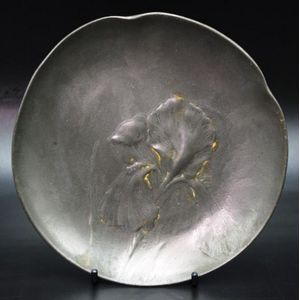
Art Nouveau Pewter Ewer with Figural Handle
Art Nouveau pewter ewer. Figural handle of a young woman with thistle branch. Silver plated planished finish. Possibly by Kayserzinn. Height 11.81 in.

Early 20th Century German Pewter Waiter/Tray
Waiter/Tray early 20th century, c1905, German Kayserzinn pewter, Zanida no 4471/43, moulded factory base mark, Kayserzinn 4503, 4.33 in. x 5.71 in.

German Kayserzinn Pewter Lily Basket Centrepiece
Basket centrepiece early 20th century, German Kayserzinn pewter, rectangular with impressed lily motif, 11.81 in. x 6.89 in.

Kayser Art Nouveau Bronze Vase with Ducks
A large bronze German Art Nouveau vase by Kayser, circa 1910, a high shouldered baluster vase with a broad neck and a lightly hammered finish to the lower register decorated with four applied ducks in flight; trademark and stamp of Kayser underside, height

Kayserzinn Pewter Floral Dish, 15cm Diameter
Vintage Kayserzinn Pewter dish embossed floral decoration, marked to base, diameter 5.91 in. approx.

Kayserzinn Art Nouveau Pewter Basket, Model #4450
A Kayserzinn Art Nouveau pewter basket, curvilinear and leaf mildly raised designs, stamped mark to the base and model #4450, length 12.52 in.

Kayserzinn Pewter Biscuit Barrel by Hugo Leven (1907)
Kayserzinn Germany pewter biscuit barrel pewter, designed by Hugo Leven, marked to base and # 4505, circa 1907, height 5.91 in.

Kayser Zinn 1902 Crumb Tray Marked 4501 (18cm)
Kayser Zinn 1902 Peter Krumenschaufer crumb tray, mark to base 4501, approx 7.09 in. long

Kayserzinn Art Nouveau Pewter Jug with Raised Pattern
German Art Nouveau Kayserzinn pewter jug with stylised raised pattern, 6.30 in. wide, 3.94 in. high

Kayserzinn Art Nouveau Jardiniere with Oak Leaves
Kayserzinn, German Art Nouveau jardiniere, decorated with oak leaves, with two branch-form handles, marked to underside, height 7.87 in. diameter 10.83 in.

German Art Nouveau Pewter Wine Cooler
A Kayserzinn German Jugendstil (Art Nouveau) large pewter wine cooler, panelled tapered cylindrical form with swollen top, relief decoration of the fable of the fox and the grapes, the thin form handles with open section, moulded mark to base and numbered

Art Nouveau Silverplated Liqueur Set with WMF Jug and Tray
Art Nouveau silverplated liqueur set. 8 pce's, WMF jug and tray, and 6 Kayser goblets on tray. Wear. Height 9.06 in. (jug)